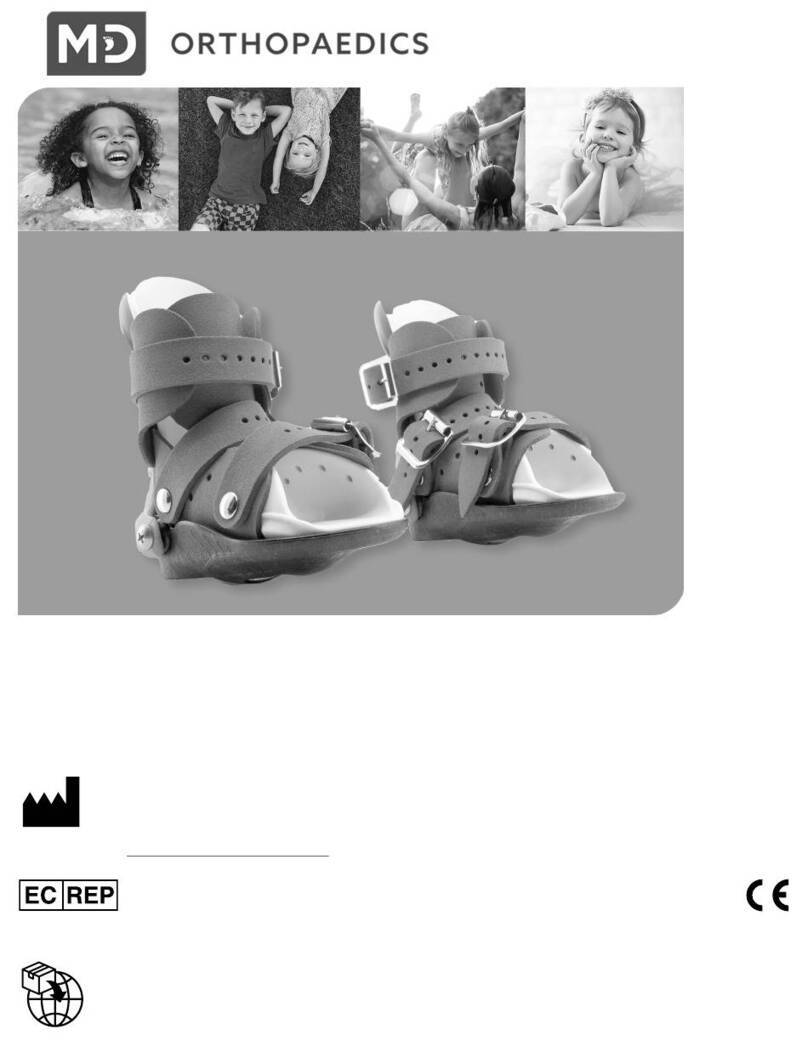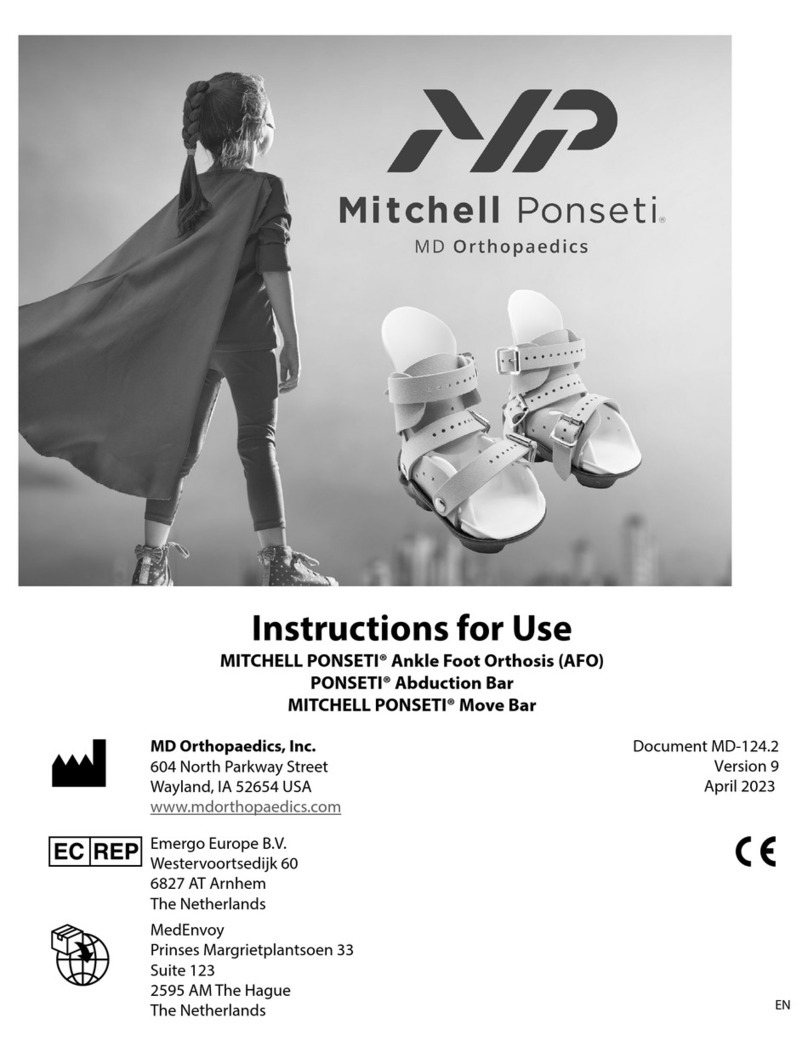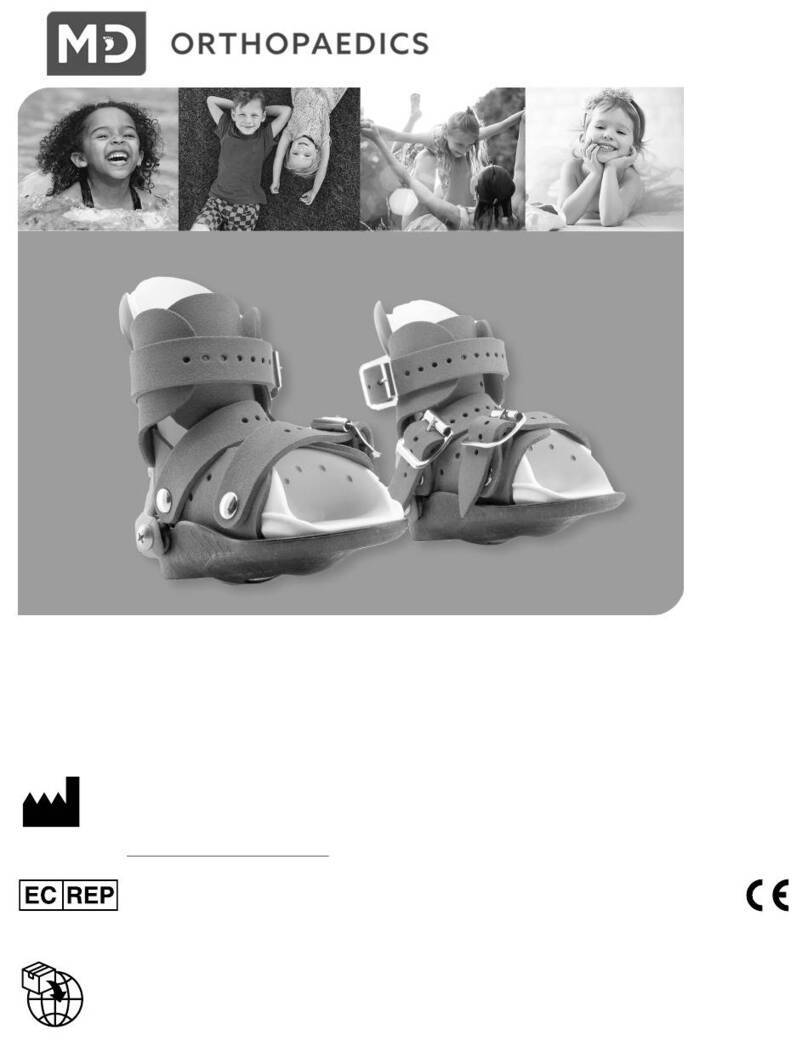
1Document MD-124
DISCLAIMER
MD Orthopaedics makes no representations or warranties with respect to this manual and, to the maximum extent permitted by law,
expressly limits its liability for breach of any warranty that may be implied to the replacement of this manual with another. Furthermore,
MD Orthopaedics reserves the right to revise this publication at any time without incurring an obligation to notify any person of the
revision.
As the designer and manufacturer of products, MD Orthopaedics does not provide medical treatment and/or advice. Information
about the risks and benets of medical treatment, including treatment that involves the use of MD Orthopaedics products and
available alternatives is provided solely by physicians or other healthcare providers. If you have questions about your child’s treatment,
itisimportant to discuss those questions with the appropriate healthcare provider.
MD Orthopaedics does not, and cannot, warrant certain results from the use of its products.
The information provided in this documentation contains general descriptions and/or technical characteristics of the performance of
the products contained herein. This documentation is not intended as a substitute for and is not to be used for determining suitability
or reliability of these products for specic user applications. It is the duty of any such user to perform the appropriate and complete risk
analysis, evaluation, and testing of the products with respect to the relevant specic application or use thereof. Neither MD Orthopaedics
nor any of its aliates or subsidiaries shall be responsible or liable for misuse of the information that is contained herein. If you have any
suggestions for improvements or amendments or have found errors in this publication, please notify us.
All pertinent state, regional, and local safety regulations must be observed when using this product. For reasons of safety and to help
ensure compliance with documented system data, only the manufacturer shall perform repairs to components.
When devices are used for applications with technical safety requirements, the relevant instructions must be followed. Failure to observe
this information can result in injury or equipment damage.
MD Orthopaedics has made every eort to prevent that the labelling, instructions for use, making available, putting into service and
advertising of devices uses text, names, trademarks, pictures and gurative or other signs that may mislead the user or the patient
regarding the device’s intended purpose, safety, and performance.
Copyright © 2023 by MD Orthopaedics, Inc.
All rights reserved. No part of this publication may be reproduced, distributed, or transmitted in any form or by any means, including
photocopying, recording, or other electronic or mechanical methods, without the prior written permission of the publisher. For permission
requests, write to the publisher at the address below.
MD Orthopaedics, Inc.
604 North Parkway Street
Wayland, IA 52654
USA
1-877-766-7384
www.mdorthopaedics.com
TRADEMARKS
Mitchell Ponseti® and Ponseti® are registered trademarks of MD Orthopaedics.
MD Orthopaedics has made every eort to supply trademark information about company names, products and services mentioned in
this manual. Trademarks shown below were derived from various sources. All trademarks are the property of their respective owners.
General Notice: Some product names used in this manual are used for identication purposes only and may be trademarks of their
respective companies.
1 PREFACE
1.1 Intended Purpose
The MITCHELL PONSETI® Ankle Foot Orthosis (AFO) with the PONSETI® Abduction Bar or the MITCHELL PONSETI® Move Bar is
known as MITCHELL PONSETI® Brace, intended for use in the Ponseti method of treatment for the correction of Congenital Talipes
Equinovarus (CTEV) in infants and children less than or equal to eight years of age. The brace is intended to prevent relapse (equinus and
varus deformity of the heel).
The MITCHELL PONSETI® Brace is to be prescribed by a physician or healthcare provider trained in the Ponseti Method of clubfoot
treatment and is typically worn for 23 hours a day for three months after casting and then during night-time and nap time for 4-5 years
or until the physician or healthcare provider indicate the device is no longer needed.
A clinical orthotist, also trained in the Ponseti method, may assist the physician or healthcare provider in determining the correct size
ofthe AFO for the child. The orthotist may also train the child’s parents and families in the right way to put the AFO onto the child’s foot,
what cues may indicate poor t or other issues, and how to determine it is time to move to the next size.
Other members of the clinical team trained in the Ponseti method – nurses, physician assistants, or other licensed healthcare
professionals – may also train parents on the proper use of the MITCHELL PONSETI® Brace and make any necessary adjustments in t
or sizing.


































